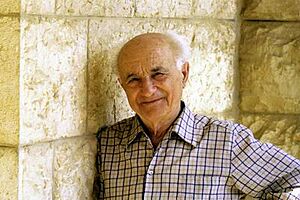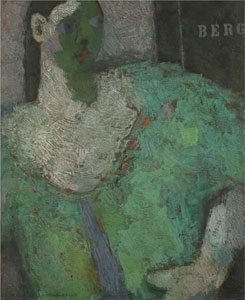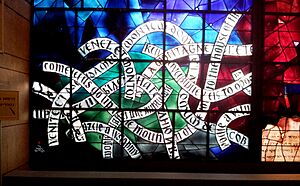Mordecai Ardon facts for kids
Quick facts for kids
Mordecai Ardon
מרדכי ארדון |
|
|---|---|

Ardon in 1977
|
|
| Born |
Max Bronstein
13 July 1896 Tuchów, Galicia, Austria-Hungary
|
| Died | 18 June 1992 (aged 95) |
| Nationality | Israeli |
| Awards | Israel Prize (1963) |
Mordecai Ardon (Hebrew: מרדכי ארדון, born July 13, 1896 – died June 18, 1992) was an important Israeli painter. He is known for his unique style that blended modern art with ancient Jewish ideas.
Contents
Who Was Mordecai Ardon?
Mordecai Ardon was born Max Bronstein in a place called Tuchów. This area was part of Austria-Hungary, but it is now in Poland. He later became a famous artist in Israel.
Early Life and Education
From 1921 to 1925, Ardon studied architecture at the Bauhaus University in Germany. This was a very famous art and design school. He learned from well-known artists like Wassily Kandinsky and Paul Klee. After his studies, he worked with Max Doerner for about a year.
In 1933, he moved to Mandatory Palestine, which is now Israel. This move is called "aliyah" (a Hebrew word for Jewish people moving to Israel). He settled in Jerusalem. In 1936, he became a British citizen of Mandatory Palestine. At this time, he changed his name to Mordecai Ardon.
Becoming a Teacher and Director
After moving to Jerusalem, Ardon started teaching art. In 1935, he became a teacher at the Bezalel Academy of Arts and Design. This is a very important art school in Israel. From 1940 to 1952, he was the director of the Bezalel Academy.
Later, from 1952 to 1963, he worked for the Israeli government. He was an artistic adviser for the Ministry of Education and Culture. This meant he helped guide art education in the country.
Ardon's Unique Art Style
Ardon's paintings often used many symbols. These symbols came from different places. He used ideas from Jewish spiritual traditions, like the Kabbalah. He also used stories from the Bible and things he saw in everyday life.
For example, in his painting "Gates of Light," he wanted to show the deep, timeless feeling of a landscape. His art often connected the present day to ancient times and mysteries. Another famous work is "At the Gates of Jerusalem" (1967). This painting showed his feelings about Israel's return to the Old City of Jerusalem during the Six-Day War.
Ardon was one of the few Israeli artists to paint about the Holocaust. His painting "Bird near a yellow wall" (1950) touched on this very serious topic.
Famous Works and Themes
One of Ardon's most famous creations is a set of large stained glass windows. These are called "Isaiah’s Vision of Eternal Peace" (1980–1984). You can see them at the National Library of Israel in Jerusalem. These windows also include visual ideas from the Kabbalah.
Ardon was seen as a very important artist in Israel. He helped shape Israeli art. His students, like Avigdor Arikha and Naftali Bezem, were influenced by his ideas. He taught them to combine personal and national symbols with real-life events. He also always stressed the importance of good painting techniques.
Later Life and Legacy
Mordecai Ardon passed away in Jerusalem in 1992. His paintings are still very valuable and important. For example, in 2014, his painting "The Awakening" (1969) was sold for $821,000 at Sotheby's. This is a famous art auction house. Another painting, "The Woodpecker of Time" (1963), sold for $643,200 at Christie's in 2006.
Awards and Recognition
Mordecai Ardon received many awards for his art and his contributions.
- 1954: Unesco Prize
- 1963: He was given the Israel Prize for painting. This is one of the highest honors in Israel.
- 1974: He received the Yakir Yerushalayim award. This means "Worthy Citizen of Jerusalem."
- 1974: He was given an honorary doctorate from the Hebrew University of Jerusalem.
- 1988: Boris Schatz Prize
- 1992: Isracard Prize from the Tel Aviv Museum
See also
- List of Israel Prize recipients
- Israeli art



